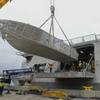Improve Chances of Survival When Abandoning Ship
The NTSB recently investigated an accident that required the crew to abandon a weather-damaged liftboat in near-hurricane-force conditions.
Several problems leading up to and during the vessel abandonment negatively impacted the 10 crewmembers’ probability of survival once they were in the water, and four of them died as a result:
- The company hurricane plan did not account for rapidly and locally developing low pressure weather systems. This reduced the crewmembers’ ability to properly plan for the developing storm and to make an early decision to leave the vessel through routine means before the onset of the storm.
- The vessel had recently been equipped with two new inflatable throw-over-type liferafts. However, the liferafts were inflated on deck instead of in the water when the crew prepared to abandon the vessel. This led to the liferafts blowing away from the vessel and vanishing in the high winds and seas. The crewmembers ended up clinging to a lifefloat, which, unlike the liferafts, did not provide out-of-water flotation, shelter from the elements, and nonperishable food and drinking water.
- Although the crewmembers had gathered additional food, drinking water, and other supplies while preparing to evacuate, they failed to take these with them.
- The vessel was equipped with an emergency position indicating radio beacon (EPIRB), which if activated would have quickly alerted authorities and narrowed the search area. However, the crewmembers did not take the EPIRB with them when they abandoned the vessel. As a result, they spent three days in the water before search and rescue assets were able to locate them.
What can mariners do?
- Develop and execute a thorough weather preparedness plan. Ensure that your plan takes into account surface low pressure systems, nontropical storms, and other weather systems that may form rapidly and locally. (For example, not all hurricanes approach from the east.)
- Ensure you know how to use safety equipment. Don’t wait until a real emergency to find out whether you know how to properly use lifesaving equipment. Instead, include in your regular weekly or monthly drills a thorough step-by-step assessment of all such equipment, especially liferafts, which can’t actually be deployed during drills.
- Plan before evacuating. Before an emergency, ensure you know your assigned duties and responsibilities―such as who’s bringing what supplies―and ensure the responsible person is aware of the location of those items.
- Drill as if it is a real emergency. Conducting realistic drills gets the attention of crewmembers, builds their confidence and proficiency in emergency response procedures, and reinforces a strong safety culture. Review drill performance with crew to identify areas for improvement.
- Even in coastal waters, plan for the worst. Despite being close to shore and/or in a normally high-traffic waterway, don’t assume that others will be able to come to your immediate aid, especially if your location changes. Be physically and mentally prepared for the possibility of a prolonged exposure situation.
- Follow your plan. In emergency situations involving high stress and exhaustion, ensure all aspects are covered by running through step-by-step emergency procedures in accordance with established checklists. Use shoreside support resources to assist you with this.
- Don’t forget the EPIRB. The EPIRB is a vital piece of equipment that can significantly shorten the time necessary to locate and rescue you. Take it with you! In addition, carry a personal locator beacon (PLB); it is an inexpensive and effective device.
- Stay together in the water. Search and rescue personnel will more easily spot a group of people in the water than dispersed swimmers.










